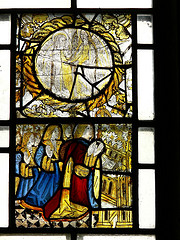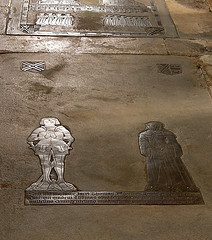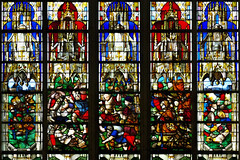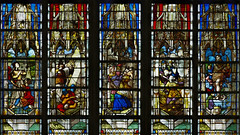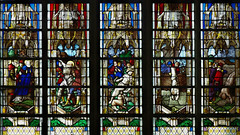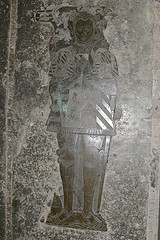PeriodIndex
The church at Saint Romain sur Cher was rebult in the C16 and restored in the C19. The north and south walls of the apse are painted with scenes of the Decapitation of John the Baptist and the Baptism of Christ on the north wall, and on the south wall is the Resurrection. Both of these paintings were restored in 1859.
This window is a composite assembly combining fragments of sixteenth-century stained glass with nineteenth-century architectural structures and extensive twentieth-century restoration. The present arrangement consists of five tall lancets surmounted by a unified canopy system reconstructed in 1852, with bases and pedestals also installed at that time.
This window (c1550) presents a sequence from the Life and Martyrdom of St Agnes, the young Roman virgin celebrated for her steadfast refusal to accept a pagan suitor and her unwavering confession of faith. Produced by a Rouen workshop in the early sixteenth century, the window follows the typical Saint-Ouen format: narrative scenes set beneath tall Gothic canopies, framed by alternating architectural and landscape elements.
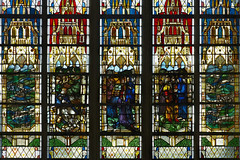
This window (c1550) is a composite assemblage combining fragments of sixteenth-century narrative glass with nineteenth-century architectural framing and extensive twentieth-century restoration. The programme appears to have depicted episodes from the life of an unidentified saint. According to Jean Lafond, one of the surviving scenes may represent the translation of relics, suggesting a cycle related either to Saint Ouen or Saint Leufroy. The identification, however, remains uncertain due to the fragmentary nature of the surviving iconography.
This window (c1550) illustrates episodes from the martyrdom of St Vincent of Saragossa, one of the most widely venerated deacons of the early Church. Created by a Rouen atelier in the early sixteenth century, the glass adopts the familiar layout of the Saint-Ouen narrative series: scenes arranged beneath richly architectural Gothic canopies, each panel presenting a distinct moment from the saint’s Passion.


